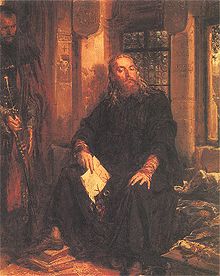Władysław (Kuyavia)

Duke Władysławs the White tombstone in the Saint Bénigne Cathedral in Dijon (A steel engraving illustration from "L'Univers - Historie et description", by Foster 1840)
|

A historical depiction by the painter Jan Matejko from the 19th century depicts Duke Władysław as a monk in Dijon, who hears news of the death of his cousin, King Casimir the Great, through a messenger. By handing over the sword, the messenger demands that the duke keep his legitimate dynastic claims to the Polish throne and then take up the battle for the Polish royal crown of the Piasts against the Hungarian Capet-Anjou.
|
Władysław the White ( Polish Władysław Biały , Latin Ladislaus * 1327 / 1330 in Kujawy , Kingdom of Poland ; † 29. February 1388 in the Free City of Strasbourg , HRR ) in the years 1347-1364 was Duke of Kuyavia in Gniewkowo and from 1370 Pretender to the Crown of the Kingdom of Poland.
With Duke Władysław the White, the line of the Kujaw Piast became extinct in the male line .
Title
- Latin title: Wladislaus dux Cuyavie et dominus Gnewkouie nec non Slonensis terrarum
- German translation: Władysław Duke of Kujawia and Lord of Gniewkowo as well as of the lands of Słońsko
Life
Władysław was the son of Duke Casimir of Kujawien , who was a cousin of the Polish king Casimir . His mother's name is unknown. After 1347 he succeeded his father in the office of the Duke of Kujawien in Gniewkowo. He inherited a relatively small domain, which his father was assigned in 1314 due to an inheritance division of the Duchy of Kujawia.
In 1359 he married Elisabeth, the daughter of Duke Albert von Strehlitz . After the sudden death of his wife after 1360, he decided to sell his lands in 1364 for a pledge of 1000 florins to the Polish king Casimir, whose liege he was formally. He then went on a pilgrimage across Europe. He visited Marienburg , Prague and the Holy Land with Jerusalem . He then moved to France , where he met Pope Urban V in Avignon and in 1366 joined the Cistercian order in Cîteaux . A year later he changed his mind and went to the Benedictines in Dijon .
After the death of the Polish king Casimir in 1370, he decided to return to Poland, although he did not succeed, despite several attempts at the Curia , to free himself from his monastic vows . When the new Polish king, Louis of Anjou , refused to give him any support, he, as the next male relative of the last Piast in the royal line (he was King Casimir the Great's second cousin), claimed the Polish throne in 1372 and started a civil war against the reigning king. In this dispute he found political support in the aristocratic opposition from the main province of Greater Poland , which was hostile to the new king , the family from the east from the Neumark and even Duke Philip of Burgundy stood up for his side. After an eventful fight (he briefly held all of Kujawy with its main castles in his hand), he finally saw that a victory was impossible. In 1377 he reached an agreement with King Ludwig in the Treaty of Brześć Kujawski , who compensated him for the assignment of his rights and inheritance claims with 10,000 florins and made him abbot in the Hungarian Pannonhalma .
Władysław went to Pannonhalma, but was only active as an abbot until around 1379 . When King Ludwig was unable to keep his promise to pay him the total amount he had promised, he returned to Poland and put the king under pressure again, who finally gave in to his demand. Władysław then traveled to France via Gdansk and Lübeck and again joined the Benedictines in Dijon.
Because of his adventurous, unstable life, he was nicknamed Le Roy Lancelot in France , which was an allusion to the fictional character of Prince Lancelot from the Arthurian novel . The death of King Ludwig in 1382 raised new hopes in Władysław, so that Pope Clement VII gave in to his insistence and released him from his monastic vows by means of a dispensation . At home, however, he neither got his duchy back, nor was he able to win the Polish throne, which subsequently went to Ludwig's daughter, Hedwig von Anjou . He left Poland for good around 1383 and stayed for a long time in the German aristocratic territories of the Holy Roman Empire, where he finally died in Strasbourg in 1388.
Duke Władysław left no heirs and was buried at his own request in the Saint Bénigne Cathedral of Dijon. With him his sex died out in the male line.
Web links and literature
- Wladyslaw the White on portal: genealogie-mittelalter.de (German).
- Joachim Lelewel : Polska dzieje i rzeczy jej. Volume 2. Nakładem Żupański, Poznań 1865, pp. 193–195, on portal: books.google.com , (Polish).
- Kazimierz Jasiński: Rodowód Piastów małopolskich i kujawskich (= Biblioteka genealogiczna. Vol. 3). Wydawnictwo Historyczne, Poznań et al. 2001, ISBN 83-913563-5-3 , (Excerpt, PDF) on portal: wydawnictwo-historyczne.pl (Polish).
- Władysław Biały (Gniewkowski) on portal: poczet.com (Polish).
Individual evidence
- ↑ Kazimierz Jasiński: Rodowód Piastów małopolskich i kujawskich (= Biblioteka genealogiczna. Vol. 3). Wydawnictwo Historyczne, Poznań et al. 2001, ISBN 83-913563-5-3 .
| personal data | |
|---|---|
| SURNAME | Wladyslaw |
| ALTERNATIVE NAMES | Władysław Biały; Ladislaus |
| BRIEF DESCRIPTION | Duke of Kuyavia |
| DATE OF BIRTH | 1327 |
| DATE OF DEATH | February 29, 1388 |
| Place of death | Strasbourg |
